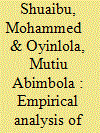|
|
|
Sort Order |
|
|
|
Items / Page
|
|
|
|
|
|
|
| Srl | Item |
| 1 |
ID:
151196


|
|
|
|
|
| Summary/Abstract |
This study reexamines the sustainability of the current account in Nigeria over four decades using time-series analysis on annual data from 1981 to 2013. We focus on two analytical distinctions to the inter-temporal budget constraint (IBC) hypothesis in relation to previous studies. First, we extend the standard bivariate approach to a multivariate framework that accounts for the roles of oil price variations and financial deepening, which have important implications for resource allocation. Second is the use of the Toda–Yamamoto modified Wald (MWALD)-based causality test that is also carried out to arbitrage between the results with and without a structural break. It employs both the conventional unit root test (augmented Dickey–Fuller [ADF] and Phillips–Perron [PP]) and the unit root test with a structural break (Perron, 2006; Zivot & Andrews, 1992). It also carries out the conventional residual-based cointegration test (Engle & Granger, 1987) and the residual-based cointegration test with a structural break (Gregory & Hansen, 1995). Findings suggest that there is current account sustainability in Nigeria and structural changes were not very potent during the period under consideration. This implies that the Nigerian economy complied with the IBC hypothesis, suggesting that exports could actually finance imports.
|
|
|
|
|
|
|
|
|
|
|
|
|
|
|
|
| 2 |
ID:
151197


|
|
|
|
|
| Summary/Abstract |
Measurement of the productivity of firms is an important research issue in productivity literature. Over the years, various methods have been developed to measure firm productivity across the globe. But there is no unanimity on the use of methods, and research on the identification of factors which determine productivity has been neglected. In view of these gaps, this study aims to measure total factor productivity (TFP) and tries to identify firm-specific factors which determine productivity of Indian manufacturing companies. The study is based on data of 616 firms from 1998–99 to 2012–13. To measure TFP, the Levinsohn–Petrin (L-P) method has been employed, and the fully modified ordinary least squares (FMOLS) method has been used to identify factors that affect TFP. The results reveal that embodied and disembodied technology plays a crucial role in the determination of productivity overall in manufacturing and other sub-industries. Similarly, the size of firms and intensity of raw material imports are also important for the determination of productivity across the sub-industries.
|
|
|
|
|
|
|
|
|
|
|
|
|
|
|
|
| 3 |
ID:
151195


|
|
|
|
|
| Summary/Abstract |
This research provides evidence in determining the predictability of exchange-traded notes (ETNs). It utilises commodity, currency and equity ETNs as data samples, and examines the performance of the three combinations of long-memory models, that is, autoregressive fractionally integrated moving average and generalised autoregressive conditional heteroskedasticity (ARFIMA-GARCH), autoregressive fractionally integrated moving average and fractionally integrated generalised autoregressive conditional heteroskedasticity (ARFIMA-FIGARCH) and autoregressive fractionally integrated moving average and hyperbolic generalised autoregressive conditional heteroskedasticity (ARFIMA-HYGARCH), and three forecasting horizons, that is, 1-, 5- and 20-step-ahead horizons, to model ETNs returns and volatilities. The article finds long-memory processes in ETNs; however, dual long-memory process in returns and volatilities is not verified. The research also poses a challenge to the weak-form efficiency hypothesis of Fama (1970) because lagged changes determine future values, especially in volatility. The findings also show that differences in the characteristics of commodity, currency and equity ETNs are not concluded because of similarities in ETN traits and several insignificant results. However, the presence of intermediate memory was identified, and should serve as a warning sign for investors not to keep these investments in the long run. Lastly, the ARFIMA-FIGARCH model has a slight edge over the ARFIMA-GARCH and ARFIMA-HYGARCH specifications using 1-, 5- and 20-forecast horizons.
|
|
|
|
|
|
|
|
|
|
|
|
|
|
|
|
| 4 |
ID:
151194


|
|
|
|
|
| Summary/Abstract |
Trade agreements are increasingly being negotiated between developed and emerging economy partners. An example is the EU–India Free Trade Agreement (FTA) for which negotiations began in 2007. There has been a debate on the potential effects of the proposed FTA and how this can impact on India’s key export sectors. Our study addresses this aspect from a global computable general equilibrium (CGE) modelling perspective. Using the Global Trade Analysis Project (GTAP) framework, we analyse trade and welfare impacts of the proposed FTA between the EU and India. Two scenarios are modelled: first, complete and immediate elimination of tariff on all goods traded and second, selective tariff elimination on textiles, wearing apparel and leather goods—products in which India has a comparative advantage. Results under both scenarios show that India enjoys positive welfare effects though there is a possibility of trade diversion. Under scenario 1, India loses due to a negative terms of trade (ToT) effect. Under scenario 2, with selective sectoral liberalisation, gains are mainly concentrated in the textiles, wearing apparel and leather sectors. There is a positive output effect from change in demand for factors of production, suggesting that the proposed FTA could lead to relocation of labour-intensive production to India.
|
|
|
|
|
|
|
|
|
|
|
|
|
|
|
|
|
|
|
|
|